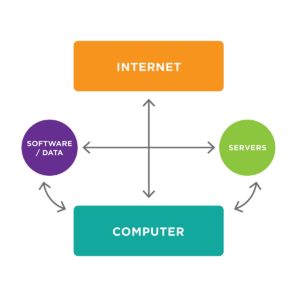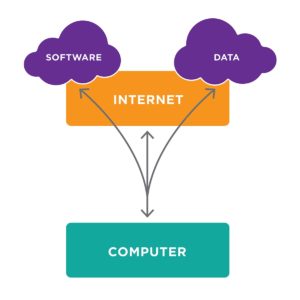A brief explanation of cloud computing
If someone mentions the benefits of cloud computing to you and your only response is, “Cloud what?”, here is a definition:
Cloud computing can be defined as “a type of internet-based computing that provides shared computer processing resources and data to computers and other devices on demand.” (source: Wikipedia)
You’re still thinking, “Cloud what?”, right? We don’t blame you, it can all seem pretty confusing. If you’re not already familiar with technology or computers, none of that definition will make much sense. To try and clear up a few things, we will explain here what cloud technology is and also why it is an essential ingredient in an efficient and cost-conscious company (one just like yours). So, are you ready? Here we go…
Before the cloud
Back in the good old days of the early internet (i.e. just before 2000, which is approximately when cloud-computing started), you had a computer, a connection, the internet, software, and a healthy amount of servers. The whole set-up looked something like this:

In this old-school example, your computer accesses the internet for various reasons, but if you need software for an application, it can come from an external source, such as a CD, or remote servers. Every time the software has an upgrade, you pay a fee, wait for the mail or courier to arrive with your new upgrades, and you physically load it into your computer, usually during business hours, and usually have to wait for the upgrade to do its magic. Alternatively, there were also Auto Updates available through accessible software already installed but these also took time, and were disruptive to the work day.
Once you have the software up and running, you will create data simply by using the software, and that data needs a home. Some computers simply do not have the memory to hold all of this, so you need some sort of external “residence” to help out. Typically, you end up using servers, which are costly and require maintenance. Also, should your servers go down or have technical problems, your information will be held hostage until the issues are resolved, and that resolution might come from an entire IT department, depending on the size of your company. Do you see how huge dollars are being directed towards the acquisition and maintenance of your data?
After the cloud
Now, let’s look at the brave new world (well, not so new anymore, but still kind of fresh) of cloud computing. With the cloud, the set-up looks something like this:

As you should be able to see from the illustration, cloud computing’s process is simplified: you have a computer, you have a connection, you have the internet. Cloud-based software “lives” in a space that is connected to the internet, and can be directly accessed by your computer through a simple connection. Upgrades and updates can occur quietly, with very little regular-hours business being disrupted, and there is generally no physical support required to accomplish the task (i.e. no CD). Oh, and all of that data you create? It also “lives” in a space supported by the internet, and is easily accessible at any time.
All of this saves you time and money, in different ways:
First, software and its upgrades/updates all occur through an internet connection with no physical components, helping to save money immediately (you’re not paying for a CD). Because software and its upgrades “live” in the cloud, they are pretty much instantly available and/or implemented. You don’t have to wait for CDs to arrive, you don’t have to wait for the software to upload onto your system (upgrades are often done at nighttime). Time is saved, and that is your time we are talking about.
Second, servers are eliminated, so not only does your cleaning crew have less to dust, but this elimination actually results in a major savings both time-wise and cost-wise. There is no need to make a major investment in equipment, you do not need an entire IT Department to deal with it, and you don’t have to maintain them physically, either (as in the cleaning crew ). Money saved, again.
Finally, and very importantly, because cloud-based software is located in an easily accessible place (the internet) by anything that has a connection, you can access your software and data from anywhere, at any time, from any device. That on its own is an incredible advantage, both in terms of cost and time.
We hope that all of that makes more sense now, and that the benefits of cloud computing are a bit clearer. Essentially, cloud-computing boils down to saving time and money and helping to make everything run more efficiently.
So, if we go back to the beginning, your response then was “Cloud what?”. Now, we hope you’re thinking “Cloud yeah.”
